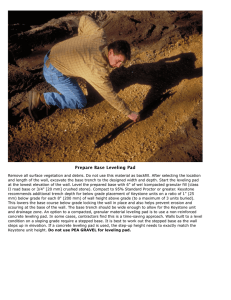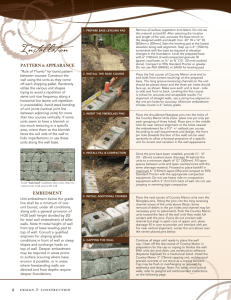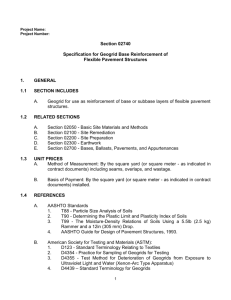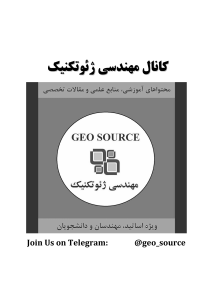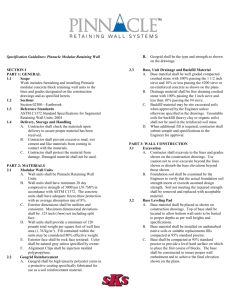KeySystem II - KeyGrid Spec Sheet PDF
advertisement
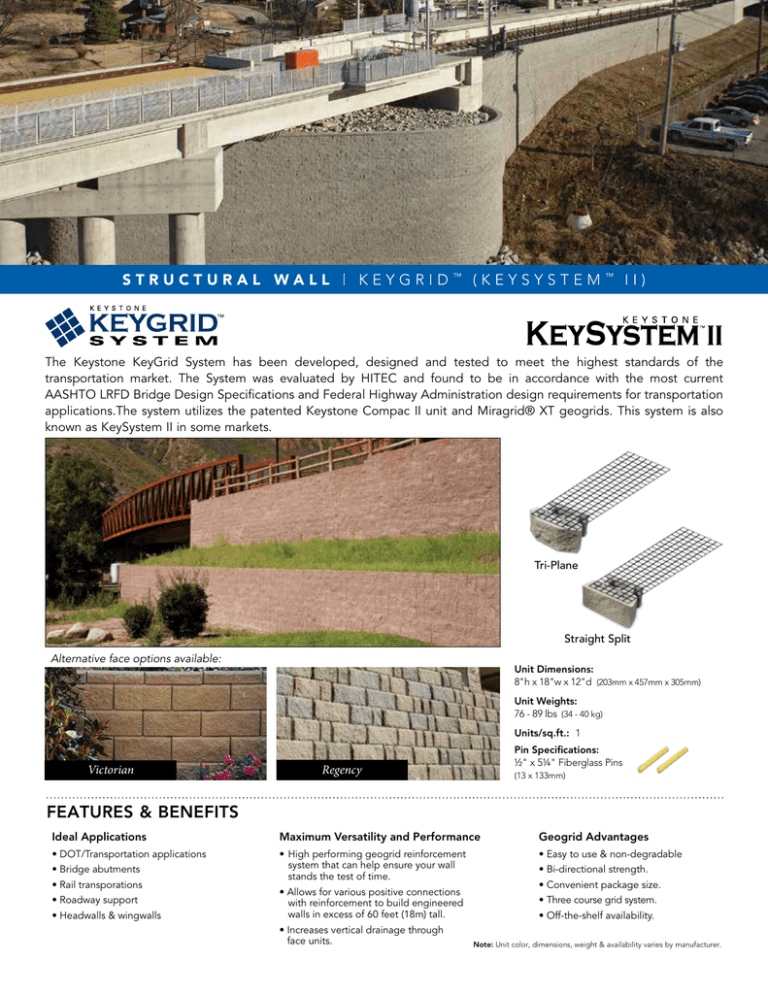
STRUCTURAL WALL | KEYGRID™ (KEYSYSTEM™ II) The Keystone KeyGrid System has been developed, designed and tested to meet the highest standards of the transportation market. The System was evaluated by HITEC and found to be in accordance with the most current AASHTO LRFD Bridge Design Specifications and Federal Highway Administration design requirements for transportation applications.The system utilizes the patented Keystone Compac II unit and Miragrid® XT geogrids. This system is also known as KeySystem II in some markets. Tri-Plane Straight Split Alternative face options available: Unit Dimensions: 8"h x 18"w x 12"d (203mm x 457mm x 305mm) Unit Weights: 76 - 89 lbs (34 - 40 kg) Units/sq.ft.: 1 Victorian Pin Specifications: ½" x 5¼" Fiberglass Pins Regency (13 x 133mm) FEATURES & BENEFITS Ideal Applications Maximum Versatility and Performance Geogrid Advantages • DOT/Transportation applications •High performing geogrid reinforcement system that can help ensure your wall stands the test of time. • Easy to use & non-degradable • Bridge abutments • Rail transporations • Roadway support • Headwalls & wingwalls • Allows for various positive connections with reinforcement to build engineered walls in excess of 60 feet (18m) tall. • Increases vertical drainage through face units. • Bi-directional strength. • Convenient package size. • Three course grid system. • Off-the-shelf availability. Note: Unit color, dimensions, weight & availability varies by manufacturer. STRUCTURAL WALL | KEYGRID™ (KEYSYSTEM™ II) INSTALLATION INSTRUCTIONS Prepare the Base Leveling Pad. STEP 1 Excavate the base trench to the designed width and depth. Start the leveling pad at the lowest elevation along the wall alignment. Step up in 8" (200mm) increments with the base as required at elevation change in the foundation. Level the prepared base with maximum lifts of 6" (150mm) of well-compacted granular fill (gravel, road base, or ½" to ¾" [10 - 20mm] crushed stone). Compact to 95% Standard Proctor or greater. Do not use PEA GRAVEL or SAND for leveling pad. STEP 2 STEP 3 STEP 4 Install the Base Course. Place the first course of Keystone units end to end (with face of wall corners touching) on the prepared base. The receiving pin holes should face upward, as shown. Make sure each unit is level. Leveling the first course is critical for accurate and acceptable results. Keystone recommends minimum embedment depth for below grade placement of Keystone units on a ratio of 1" (25mm) below grade for each 8" (200mm) of wall height above grade or one unit, whichever is greater. Insert the Fiberglass Pins. Place the straight fiberglass pins into the holes of each Keystone unit as required. Once placed, the pins create an automatic setback for the additional courses. Place pins in the front holes for near vertical (1⁄8" or [3mm]) setback and the rear holes for 11⁄8" (29mm) setback per course. STEP 5 Install Additional Courses. Place the next course of Keystone units over the fiberglass pins, fitting the pins into the triangular shaped receiving hole in the units above. Push the units toward the face of the wall until they make full contact with the pins. Continue backfilling and building to desired top elevation. Install Geogrid Reinforcement Remove existing soils in the reinforced soil area to the maximum embedment length of the geogrid design. Provide a generally level soil condition behind the wall units for the placement of each geogrid layer. Cut sections from geogrid roll to the specified length (embedment depth). Geogrid roll direction is from the wall toward the embankment. Check manufacturer’s criteria for biaxial or uniaxial geogrids. In most cases correct orientation is to roll the geogrid perpendicular to the wall STEP 5 (Geogrid) face. Hook geogrid over the Keystone fiberglass pins to ensure a positive mechanical connection between the unit and geogrid. Make sure geogrid is placed within 1 inch of wall face.Pull the pinned geogrid taut to eliminate loose folds. Stake or secure back edge of geogrid before and during backfill and compaction. Remove stakes, if desired, once backfill is placed. Place additional sections of geogrid, abutting each other, for continuous coverage at each layer.Provide a minimum of 6" (150 mm) reinforced fill coverage prior to driving equipment over the geogrid with tired equipment. Avoid driving or turning vehicles directly on geogrid to avoid excessive damage Install Fill & Compaction. Provide ½"-¾" (10 - 20mm) clean crushed stone drainage fill behind the units to a minimum distance behind the tail of one foot (300mm). Fill all open spaces between units and open cavities/cores with the same drainage material. Proceed to place backfill in maximum 6-8" (150 - 200mm) layers and compact to 95% Standard Proctor with the appropriate compaction equipment. Capping the Wall. Complete your wall with the appropriate Keystone capping units. With units dry and clean, use exterior construction grade adhesive on the top surface of the last course before applying cap units. Backfill and compact to finish grade. STEP 6 Keystone Retaining Wall Systems LLC • A Contech Company 4444 West 78th Street • Minneapolis, MN 55435 (952) 897-1040 • www.keystonewalls.com ©2015 Keystone Retaining Wall Systems LLC
